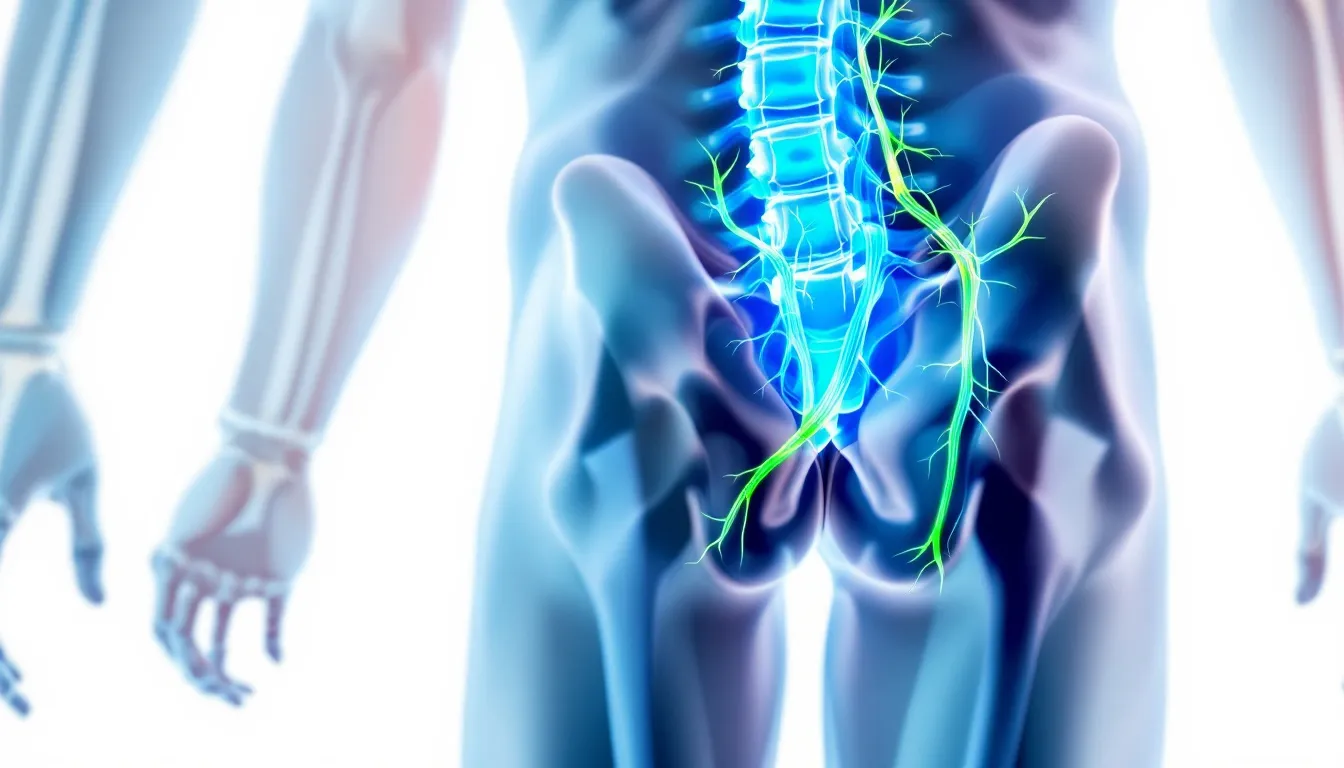Can a Chiropractor Help with Sciatica Pain Relief?
Can a chiropractor help with sciatica? Yes, chiropractors can provide effective relief for sciatica through spinal adjustments and other treatments. This article will explain how and why chiropractic care works for sciatica.
Key Takeaways
- Sciatica is characterized by pain caused by pressure on the sciatic nerve, often leading to severe discomfort and mobility issues if untreated.
- Chiropractic care provides a non-invasive approach to alleviate sciatica symptoms through techniques like spinal manipulation and targeted therapies.
- Regular chiropractic treatment not only offers immediate pain relief but also promotes long-term spinal health, reducing the risk of future sciatica episodes.
Understanding Sciatica

Sciatica is a condition caused by pressure on the sciatic nerve, the longest nerve in the body. This nerve runs from the lower back through the hips and down each leg, and when it’s compressed or irritated, the result can be excruciating leg pain. Sciatic pain typically manifests as sharp, shooting pain that radiates from the lower back down through the leg, often accompanied by numbness, tingling, and muscle weakness.
Pinpointing the root cause of sciatica ensures more effective treatment. Common culprits include herniated disks, bone spurs, or spinal stenosis. For example, a herniated disk can press against the sciatic nerve, causing significant discomfort and mobility issues. Without proper diagnosis and intervention, sciatica can lead to more serious complications, such as persistent muscle spasms and even permanent nerve damage.
Symptoms of sciatica are not just limited to pain. Many individuals experience a range of sensations, from a dull ache to a severe burning or shooting pain. This discomfort can be exacerbated by prolonged sitting, sudden movements, or even coughing. In severe cases, sciatica can lead to difficulty walking or standing, severely impacting one’s quality of life.
Addressing sciatica early is crucial. Left untreated, it can progress from a temporary inconvenience to a chronic issue, disrupting daily activities and overall well-being. Seeking medical attention at the first sign of sciatica symptoms can prevent these complications and facilitate a quicker recovery.
How Chiropractic Care Alleviates Sciatica Symptoms

Chiropractic care provides a non-invasive, holistic method for managing sciatica pain. Chiropractors focus on diagnosing and treating musculoskeletal issues, particularly spinal health. Techniques such as spinal manipulation, soft tissue therapy, and targeted massage are employed to alleviate sciatica symptoms and promote overall well-being.
The main objective of chiropractic care for sciatica is to relieve pressure on the sciatic nerve, offering significant pain relief. This is achieved through various methods, including spinal adjustments that correct misalignments and restore proper function to the spine. Chiropractor help with sciatica targets the underlying causes of sciatica to alleviate symptoms and prevent recurrences.
Chiropractic treatments are tailored to each patient’s specific needs. This personalized approach ensures that the treatments are effective in promoting healing and providing long-term relief from sciatic nerve pain. Enhancing spinal alignment and improving mobility through chiropractic care alleviates symptoms and promotes overall spinal health.
Chiropractic Adjustments for Sciatica Pain
A primary technique for treating sciatica is spinal manipulation, which involves adjusting the spine to correct misalignments and relieve pressure on the sciatic nerve. Spinal adjustments are particularly effective in cases where sciatica is caused by a herniated disk or bone growths in the lumbar spine.
Spinal adjustments offer multifaceted benefits. Realigning the spine reduces nerve compression and alleviates sciatic nerve pain. This not only provides immediate pain relief but also restores function and improves mobility. Additionally, spinal adjustments can reduce inflammation, which is often a contributing factor to sciatica symptoms.
Personalized treatment plans are essential for effective sciatica management. Chiropractors assess each patient’s condition and tailor treatments to address specific causes of pain. This may involve a combination of spinal adjustments, physical therapy, and other techniques designed to promote healing and alleviate symptoms.
Beyond pain relief, chiropractic adjustments contribute to overall spinal health. Proper spinal alignment helps reduce the risk of future sciatica episodes, enhancing mobility and flexibility. Regular chiropractic care plays a crucial role in managing sciatica and preventing its recurrence.
Additional Chiropractic Treatments for Sciatica Relief

In addition to spinal adjustments, chiropractors offer a range of complementary treatments to relieve sciatica pain. Cold laser therapy, for example, enhances blood flow and decreases inflammation, offering effective relief for sciatic nerve pain. This non-invasive treatment can target deep tissues, promoting healing and reducing discomfort.
Massage therapy is another effective treatment for sciatica. By targeting tight muscles and promoting deep relaxation, chiropractic massage can alleviate muscle tension and relieve pain by releasing endorphins, the body’s natural painkillers. This method offers immediate relief and supports long-term healing by improving circulation and reducing muscle spasms.
Ultrasound therapy is also used to treat sciatica. This technique generates gentle heat that penetrates deep tissues, improving circulation and reducing pain. Combined with spinal decompression techniques, which increase space between vertebrae and relieve pressure on the sciatic nerve, these treatments offer a comprehensive approach to managing sciatica symptoms.
Lifestyle Changes Recommended by Chiropractors
Chiropractors frequently recommend lifestyle changes to complement treatments and prevent future sciatica episodes. Good posture relieves lower back pressure and prevents sciatic nerve irritation. Using ergonomic chairs and practicing proper posture can significantly reduce the risk of future sciatica episodes.
Regular exercise and staying active are crucial for managing sciatica. Chiropractors advise avoiding prolonged sitting and incorporating regular movement into daily routines. Proper lifting techniques, such as using the legs rather than the back, can also help prevent back strain and reduce the likelihood of developing sciatica.
Chiropractors offer guidance on lifestyle changes to enhance the benefits of adjustments. This includes advice on posture, exercises, and ergonomic adjustments to maintain proper spinal alignment and overall spinal health. Regular chiropractic visits play a crucial role in maintaining spine health and reducing the risk of recurrence.
When to Seek Help from a Chiropractor
Recognizing signs that indicate the need for chiropractic care is key for effective sciatica management. Pain during movements like bending or lifting suggests it’s time to see a chiropractor. If sciatica symptoms disrupt daily activities, it may be necessary to seek chiropractic treatment.
Persistent numbness or tingling in the legs indicates the need for immediate chiropractic evaluation. Experiencing weakness in the leg can indicate severe nerve involvement, warranting prompt chiropractic care. Chronic pain persisting beyond a few days also indicates the need for chiropractic consultation.
Timely intervention prevents complications from untreated sciatica, such as nerve damage and lasting numbness or weakness. If previous conservative treatments have been ineffective, it may be time to explore chiropractic options. Recognizing these signs can help ensure timely chiropractic intervention for effective sciatica management.
Long-term Benefits of Chiropractic Care

Regular chiropractic care provides numerous long-term benefits for those suffering from sciatica. Spinal adjustments contribute to long-term relief by maintaining proper spinal function and alignment, reducing the likelihood of nerve impingement. This preventive approach helps reduce the risk of future sciatica episodes and supports overall spinal health.
Consistent chiropractic treatment enhances overall mobility and flexibility, facilitating pain-free daily activities. Improved posture is another benefit of regular chiropractic care, as maintaining proper alignment alleviates pressure on the spine and prevents irritation of the sciatic nerve.
Long-term chiropractic care not only provides immediate pain relief but also supports the healing process and promotes overall spinal health. Addressing the underlying causes of sciatica and maintaining spinal alignment through chiropractic care helps individuals live pain-free and prevents future episodes.
Dr. Sirota Is an Expert Chiropractor in White Plains & Stamford
Dr. Jonathan Sirota is a renowned chiropractor with over 35 years of experience in chiropractic care. His practice, located in both White Plains, NY, and Stamford, CT, allows him to serve a broad community and provide tailored treatment plans to his patients. Dr. Sirota’s expertise in correcting muscle imbalances and joint issues has helped many individuals achieve significant improvements in their conditions.
Patients often report notable improvements after their first visit to Dr. Sirota, highlighting his effectiveness in providing chiropractic care. As a certified Chiropractic Sports Physician, Dr. Sirota has contributed to advancements in chiropractic techniques, further establishing his reputation as an expert in the field.
Whether you’re dealing with sciatica pain or other musculoskeletal issues, Dr. Sirota’s approach to chiropractic care ensures that you receive comprehensive and personalized treatment. His emphasis on correcting muscle and joint imbalances makes him a leading sciatica chiropractor in the region.
Summary
In summary, sciatica is a painful condition that can significantly impact one’s quality of life. Chiropractic care offers a non-invasive and effective solution for managing and alleviating sciatica symptoms. By addressing the root causes of sciatica, chiropractors can provide significant pain relief and promote overall spinal health.
If you’re experiencing sciatica pain, consider seeking the help of a qualified chiropractor like Dr. Jonathan Sirota. With the right treatment and lifestyle changes, you can achieve long-term relief and prevent future episodes of sciatica. Don’t let sciatica hold you back—take the first step towards a pain-free life today.
Frequently Asked Questions
What causes sciatica pain?
Sciatica pain is primarily caused by pressure on the sciatic nerve, which can result from herniated discs, bone spurs, or spinal stenosis. Addressing these underlying conditions is crucial for effective pain relief.
How can chiropractic adjustments help with sciatica?
Chiropractic adjustments can significantly alleviate sciatica symptoms by realigning the spine, which reduces nerve compression and relieves pressure on the sciatic nerve. This can lead to improved mobility and decreased pain.
What are some additional chiropractic treatments for sciatica relief?
For effective sciatica relief, consider additional chiropractic treatments such as cold laser therapy, massage therapy, ultrasound therapy, and spinal decompression techniques. These therapies can enhance recovery and alleviate pain.
When should I seek help from a chiropractor for sciatica?
You should seek help from a chiropractor for sciatica if you experience increased pain during movement, persistent numbness or tingling, or leg weakness. Taking action sooner rather than later can help prevent further complications and alleviate discomfort.
What are the long-term benefits of chiropractic care for sciatica?
Chiropractic care for sciatica offers long-term benefits such as improved spinal alignment, decreased risk of future sciatica episodes, enhanced mobility and flexibility, and overall better spinal health. These advantages contribute to a more active and pain-free lifestyle.



